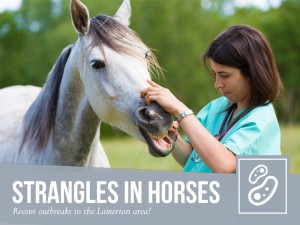
Strangles in horses - Recent outbreaks in the Lamerton area!

We would like to share with you some information about Strangles since there have been outbreaks of this disease in the Lamerton area recently. Strangles is a highly contagious, infectious disease of horses caused by a bacteria called Streptococcus equi.
This is a debilitating disease that causes depression, fever, loss of appetite, cough, thick creamy nasal discharge, and swelling of the lymph nodes in their jaw or throat areas. As time goes by abscesses can develop on their lymph nodes and these abscesses often burst discharging a thick creamy-yellow pus. The pus is extremely infectious. The disease is called Strangles because the glands can increase in size and can restrict the horse's airways.
Strangles can be life-threatening although it is a rare occurrence. In these cases, the bacteria spreads through the bloodstream and abscesses can develop in other organs. It can also lead to small areas of bleeding and swelling in the limbs, eyes and gums due to fluid accumulation.
Strangles can affect horses of any age, sex or breed. However, young, older and debilitated horses are often most susceptible to an outbreak. The disease is spread by direct or indirect contact, usually by direct nose to nose contact of horses with nasal discharges or with material from burst abscesses. It can also be indirectly transmitted through handlers or objects such as feed buckets or grooming equipment.
Clinical signs can appear 2-21 days after the horse has been infected. A small number of infected horses (about 10%) can become carriers, which means they can spread this disease while appearing healthy. If left untreated, carriers can cause new outbreaks. This is likely to happen when their immune system becomes debilitated for some reason, if they become stressed about moving to a new yard for example.
If you suspect your horse may be suffering from this disease do not hesitate to contact your vet. If you strongly suspect there is an outbreak or if this is confirmed please make sure you keep your horses isolated as well as any horse that may have been in contact with them. Talk to your vet to help institute an isolation protocol for your horses. Inform everyone who comes in contact with them to insure none of the isolation measures are neglected. Most horses recover from this disease in a few weeks with adequate treatment and strict biosecurity measures.
In order to protect your horses against this and other diseases it is recommended to quarantine new horses for three weeks before allowing them to come into contact with your other resident horses. You can also talk to your vet about what routine tests should be performed before bringing in a new horse into your yard.
It is really worth having a look at the ´HBLB Strangles guidelines in the Codes of Practice` and the ´Strategy To Eradicate and Prevent Strangles` documents available at the HBLB website so you can be informed and have a biosecurity management plan ready, if you ever have to deal with an outbreak.
Would you like to know more about horses? Check our Equine Courses:
Equine courses
Published: 14 Feb 2016
Read the previous article: Alabama Rot Disease

